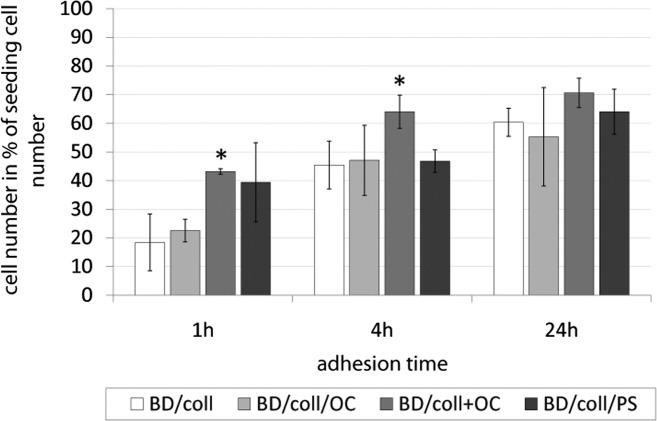Collagen and noncollagenous proteins of the extracellular bone matrix are able to stimulate bone cell activities and bone healing. The modification of calcium phosphate bone cements used as temporary bone replacement materials with these proteins seems to be a promising approach to accelerate new bone formation. In this study, we investigated adhesion, proliferation, and osteogenic differentiation of human bone marrow stromal cells (hBMSC) on Biocement D/collagen composites which have been modified with osteocalcin and O-phospho-L-serine. Modification with osteocalcin was carried out by its addition to the cement precursor before setting as well as by functionalization of the cement samples after setting and sterilization. hBMSC were cultured on these samples for 28 days with and without osteogenic supplements. We found a positive impact especially of the phosphoserine-modifications but also of both osteocalcin-modifications on differentiation of hBMSC indicated by higher expressions of the osteoblastic markers matrix metalloproteinase-13 and bone sialo protein II. For hBMSC cultured on phosphoserine-containing composites, an increased proliferation has been observed. However, in case of the osteocalcin-modified samples, only osteocalcin adsorbed after setting and sterilization of the cement samples was able to promote initial adhesion and proliferation of hBMSC. The addition of osteocalcin before setting results in a finer microstructure but the biological activity of osteocalcin might be impaired due to the sterilization process. Thus, our data indicate that the initial adhesion and proliferation of hBMSC is enhanced rather by the biological activity of osteocalcin than by the finer microstructure.

Collagen and noncollagenous proteins of the extracellular bone matrix are able to stimulate bone cell activities and bone healing. The modification of calcium phosphate bone cements used as temporary bone replacement materials with these proteins seems to be a promising approach to accelerate new bone formation. In this study, we investigated adhesion, proliferation, and osteogenic differentiation of human bone marrow stromal cells (hBMSC) on Biocement D/collagen composites which have been modified with osteocalcin and O-phospho-L-serine. Modification with osteocalcin was carried out by its addition to the cement precursor before setting as well as by functionalization of the cement samples after setting and sterilization. hBMSC were cultured on these samples for 28 days with and without osteogenic supplements. We found a positive impact especially of the phosphoserine-modifications but also of both osteocalcin-modifications on differentiation of hBMSC indicated by higher expressions of the osteoblastic markers matrix metalloproteinase-13 and bone sialo protein II. For hBMSC cultured on phosphoserine-containing composites, an increased proliferation has been observed. However, in case of the osteocalcin-modified samples, only osteocalcin adsorbed after setting and sterilization of the cement samples was able to promote initial adhesion and proliferation of hBMSC. The addition of osteocalcin before setting results in a finer microstructure but the biological activity of osteocalcin might be impaired due to the sterilization process. Thus, our data indicate that the initial adhesion and proliferation of hBMSC is enhanced rather by the biological activity of osteocalcin than by the finer microstructure.
